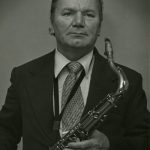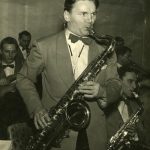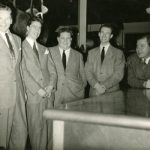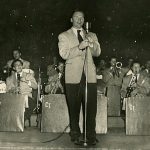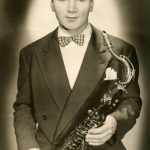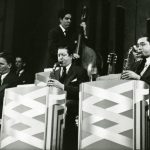Theodore “Ted” Goddard (1917-1988)

My father, also named Ted Goddard, was a professional musician for more than five decades. From the 1930s until his death in the summer of 1988, he played saxophones (alto, tenor, and baritone) and clarinet with many top-name orchestra leaders, jazz musicians, and entertainers. Here are some of his life’s circumstances and career highlights.
Theodore R. “Ted” Goddard was born in Everett, Massachusetts on August 22, 1917 to Alfred James Goddard (1874-1960) and Elva Elizabeth Grove (1879-1981) at their family home on Harley Avenue. The tenth of eleven children, his siblings included Edith (1901-99), Louise (1902-83), Ellsworth (1904-60), Alden (1906-85), Doris (1908-74), Elva (1910-2008), the twins Mabel (1912-2006) and Marie (1912-89), Ruth (1915-95), and Alfred (1922-86).
Ted was exposed to music since childhood. His grandfather, Alfred J. Goddard Sr., was a symphonic trombonist and a violinist with the Royal Orchestra (Queen Victoria’s band) in England. His uncle George W. Goddard performed with both the Boston Philharmonic and John Philip Sousa. Encouraged to pursue music, and fascinated with musical sounds, Ted wanted to ‘blow a horn’ and learn jazz. He began studying the alto saxophone with Mr. Fields in Hampstead, NH, then advanced to tutoring at the New England Conservatory of Music and private saxophone lessons with Andrew Jacobson in Boston. Motivated to practice every day after school, often for eight to ten hours a day, he studied and applied music theory, learned solfeggio, developed sight-reading and aural-perception skills, and began to improvise by imitating music heard on records and radio broadcasts. By age fifteen, he had won membership in the “Young Musicians Orchestra” of Boston’s Metropolitan Theatre.
Growing up during the Jazz Age, Ted was inspired by early-jazz and swing musicians, notably Louis Armstrong, Coleman Hawkins, Ben Webster, Lester Young, et al., and the bands of Fletcher Henderson, Duke Ellington, and Count Basie. While still in high school, sometimes alongside younger buddies Paul Gonsalves and Jimmy Mosher, he began playing local dance jobs with Boston bandleaders Al Donahue and Mal Hallett earning as much as $2.00 a night. Red Norvo heard Ted play and offered the young saxophonist a job with his big band. Ted’s mother, however, insisted that he complete the education program at Medford (MA) High School before going out on the road; after graduation, job offers were waiting.
Coming of age in the swing era, Ted worked with several prominent big-band leaders from the mid 1930s through the early 1950s: Tommy Reynolds (1938), Red Norvo (1938-40), Claude Thornhill (1940-42), Benny Goodman (1942), Richard Himber (1942), Jerry Wald (1943), Teddy Powell (1943), Hal McIntyre (1943-44), and Boyd Raeburn (1944) among them. Besides fellow band mates Dizzy Gillespie, Barry Galbraith, Allen Hanlon, Irving Fazola, Conrad Gozzo, Rusty Dedrick, Irv Cottler, Danny Hurd, Eddie Safranski and many others, Ted also played in small groups with Roy Eldridge, Frankie Newton, Clark Terry, Vic Dickenson, and Charlie Ventura. During the 1940s, gigs in New York City provided nightly opportunities to attend Harlem jam sessions where he heard and shared the bandstand with swing veterans and emerging beboppers; at an all-night session in New Jersey, he jammed with alto saxophonist and bebop architect Charlie Parker. After two years in the U.S. Army band (1944-46), Ted regrouped with the Thornhill Orchestra (1946-47), and then played behind Vaughn Monroe (1947-51) with whom he toured more than 60,000 miles throughout the United States and Canada. Besides leading his own musical groups since the 1950s, Ted worked with several bands including New Hampshire’s Ted Herbert Orchestra, Mel and Jean Sibulkin, and Boston’s Sabby Lewis Orchestra and Sextet.
Although his career brought many musical highs, one of Ted’s greatest thrills was backing singer Billie Holiday at Boston’s Hi-Hat jazz club in the early 1950s. He also appears improvising a tenor-sax solo with McIntyre’s band in the movie Hey, Rookie (1944), Columbia Pictures’ wartime musical starring Ann Miller, Joe Besser, and Larry Parks (special thanks to Mark Cantor of Celluloid Improvisations and his efforts to document jazz in film). Metronome magazine’s jazz poll voted him into the top ten of nationally known saxophonists, and in May of 1985 Boston Globe writer Ernie Santosuosso named Ted to his roster of outstanding “all-star born-in-Massachusetts jazz band” musicians.
Ted Goddard was a lifetime member of the American Federation of Musicians.
About Ted Goddard . . .
It is interesting to note that a whole succession of tenor players in [Hal] McIntyre’s band–men like Ted Goddard and Johnny Hayes–had all thoroughly mastered [Ben] Webster’s personal style, both in up-tempo jazz and ballad solos. . . . The McIntyre soloists’ contributions–Hayes’s and Goddard’s Webster-ish excursions and McIntyre’s own beautiful alto work, much indebted to Johnny Hodges–should not be overlooked.
̶ Gunther Schuller, “The Swing Era: The Development of Jazz 1930-1945”
. . . Of the original orchestra, [Claude] Thornhill found most of his key men out of work when Red Norvo’s band folded: lead trumpeter Conrad Gozzo; the Beriganian soloist Rusty Dedrick; Ted Goddard, an ace on both hot tenor and Benny Carter-inspired alto; as well as singer Lillian Lane.
̶ Will Friedwald, “Best of the Big Bands: Claude Thornhill” program notes (Columbia 46152)
Downbeat raved about the entire Thornhill reed section [“Claude Thornhill, Band of the Year,” Downbeat Magazine review from the Hotel Pennsylvania in New York City, 21 October 1946] saying it was ‘stuffed with talent.’ It included Ted Goddard who reminded DB of Benny Carter. He passed through the bands of Glenn Miller, Red Norvo, Boyd Raeburn, and Hal McIntyre. . . . I always enjoyed Ted’s alto, but he reminded me more of Willie Smith.
̶ Buddy Hughes, vocalist with the Claude Thornhill Orchestra
. . . the ingenious altoing of Ted Goddard.
̶ George T. Simon, “Thornhill: Best Potential Popularity Bet,” Metronome Magazine, May 1941
The impact of his playing served as one of the great saxophone lessons of my life. I remember his great tone and how it changed my consciousness of what a saxophone could sound like. . . . His sound on baritone was just as wonderful as the tenor and alto. I also thought he was one of the great jazz singers. His vocal expression mirrored so nicely his saxophone expression in the best tradition of jazz instrumentalists who also sing. He was a sweet man and a wonderful musical force in my life that I shall never forget.
̶ Larry Monroe, saxophonist, Berklee College of Music
My fondest memories of Ted are driving, although we enjoyed many, many, many great times playing together. I think some of the greatest insights into his personality and his warmth came from sitting with him and talking one on one, with Ted telling us some of his experiences in the Big-Band Era. Passing on those experiences to us is a great legacy. . . . Ted’s love of playing was evident to everybody and some of the jewels that he produced were greatly appreciated by musicians. Ted, I’m going to miss those long drives!
̶ Dr. Martin Schwartz, oral surgeon and jazz trumpeter
I’ve just listened to your dad on bari with Ted Herbert. He sounds great! Totally relaxed, melodic, swinging, and great ideas. . . . He was a beautiful player–now I know what Bill Pierce and Billy Thompson were talking about!
̶ Allan Chase, saxophonist, Berklee College of Music
Ted Goddard was a great jazz artist. His modern, lyrical, swinging playing was reminiscent of Pres, the great Lester Young, but with Ted’s own original approach. We really dug Ted’s playing. I remember a session at our house where Ted came to play and brought Barry Galbraith!
̶ Bob Ingalls, guitarist
Talked to Red Norvo recently. He expressed regret that your dad and I had not recorded with his band (because of the union ban on recording). Your dad, of course we all know, was a giant!
̶ Rusty Dedrick, arranger and trumpeter with the Claude Thornhill Orchestra
I used to play guitar with your dad in New Hampshire and around greater Boston. Your dad was a wonderful man and I learned so much from him—not only about music, but how to be a human being. [He] was a big influence in my life and I have fond memories that will stay with me to the end.
— Bob Johnson, guitarist
Ted Goddard: Selected Discography
Evans, Gil. The Complete Instrumental Charts for Claude Thornhill: 1942-1947. Program notes by Laurent Cugny and Alain Tercinet. Masters of Jazz, MJCD 154.
________. The Real Birth of the Cool: Featuring Claude Thornhill and his Orchestra. Program notes by J.G. Calvados. The Jazz Factory, JFCD22803.
Fazola, Irving. The Rarest Recordings of Irving Fazola (1936-1945). Swing Time Records, CD9905.
Gillespie, Dizzy. Volume 5, 1945, Complementary Works. Media 7, MJCD 110.
Goodman, Benny. One Night Stand with Benny Goodman in 1942 and 1943. Joyce LP-1073.
McIntyre, Hal. The Greatest Recordings of the Big Band Era. Program notes by George T. Simon. The Franklin Mint Record Society, 35/36.
________. Hal McIntyre and his Orchestra: 1943-46. Program notes by Danny Hurd. Hindsight Records, HSR-172.
Monroe, Vaughn. The Greatest Recordings of the Big Band Era. Program notes by George T. Simon. The Franklin Mint Record Society, 5/6.
________. This is Vaughn Monroe. RCA Victor, VPM-6073.
Powell, Teddy. Teddy Powell and his Orchestra (1942-43). First Time Records, FTR-1509.
Raeburn, Boyd. Boyd Raeburn and his Orchestra: Out of This World. Sounds of Swing, LP-115.
________. Boyd Raeburn: Rare 1944-46 Broadcast Performances. Program notes by Jack McKinney. International Association of Jazz Record Collectors, IAJRC 48.
________. The Greatest Recordings of the Big Band Era. Program notes by George T. Simon. The Franklin Mint Record Society, 5/6.
Thornhill, Claude. Best of the Big Bands: Claude Thornhill. Program notes by Will Friedwald. Columbia Records, CK 46152.
________. Buster’s Last Stand. Program notes by Alastair Robertson. HEP Records, UK, HEP CD 1074.
________. Claude Thornhill and his Orchestra: 1941 & 1947. Program notes by Roberta Stein and George H. Buck, Jr. Circle Records, CCD-19.
________. Claude Thornhill and his Orchestra: The 1946-47 Performances Vol. 1. Program notes by Loren Schoenberg. HEP Records, UK, HEP CD 72.
________. Claude Thornhill and his Orchestra: 1946-47 Performances Vol. 2. Program notes by Alastair Robertson. HEP Records, UK, HEP CD 74.
________. Claude Thornhill and his Orchestra Play for Dancing. Design Records, DLP-106.
________. Claude Thornhill and his Orchestra: The Rare Columbia Recordings. Program notes by Eric Berman and Gary Theroux. Sony Music, COL-CD-7549.
________. Claude Thornhill at Glen Island Casino 1941. Program notes by Bill Borden. Monmouth-Evergreen Records, MES 7024.
________. Claude Thornhill: Autumn Nocturne, Volume 2. Program notes by Ian Crosbie. HEP Records, UK, HEP CD 1060.
________. Claude Thornhill In Disco Order: Volume 2. AJAZ LP-210.
________. Claude Thornhill In Disco Order: Volume 3. AJAZ LP-218.
________. Claude Thornhill In Disco Order: Volume 4. AJAZ LP-226.
________. Claude Thornhill In Disco Order: Volume 5. AJAZ LP-234.
________. Claude Thornhill: Snowfall, Volume 1. Program notes by Ian Crosbie. HEP Records, UK, HEP CD 1058.
________. Dance to the Sound of Claude Thornhill and his Orchestra. Program notes by Burt Korall. Decca, DL 8878.
________. Dancing After Midnight. Columbia Records CL-709.
________. The Memorable Claude Thornhill. Program notes by Irving Townsend. Columbia Records, KG 32906.
________. One Night Stand with Claude Thornhill. Program notes by Bill O’Donnell. Joyce Music Publications, JOYCE LP-1015.
________. Sleepy Serenade. Design Records, DLP-50.
Special thanks to Alastair Robertson and HEP Records.

Ted Goddard (bari)
